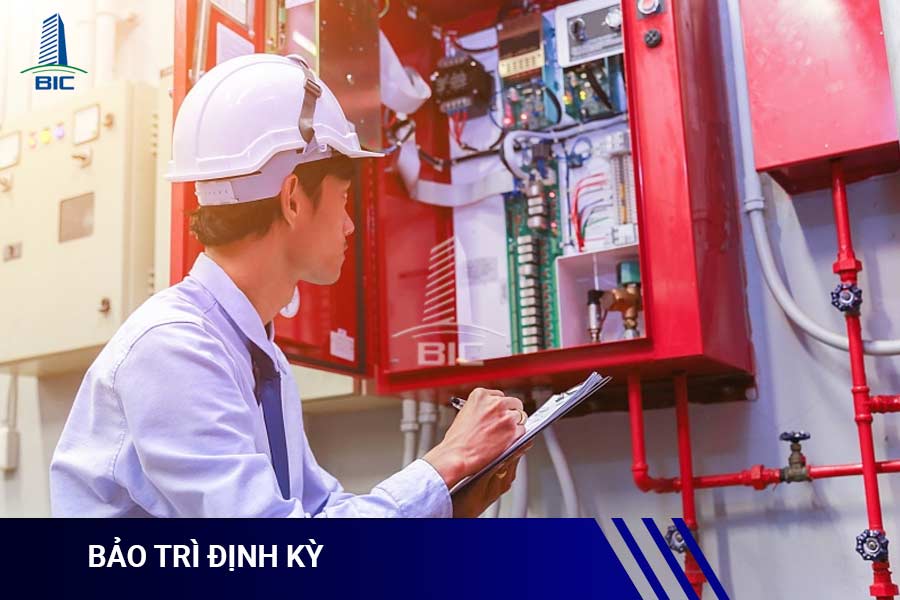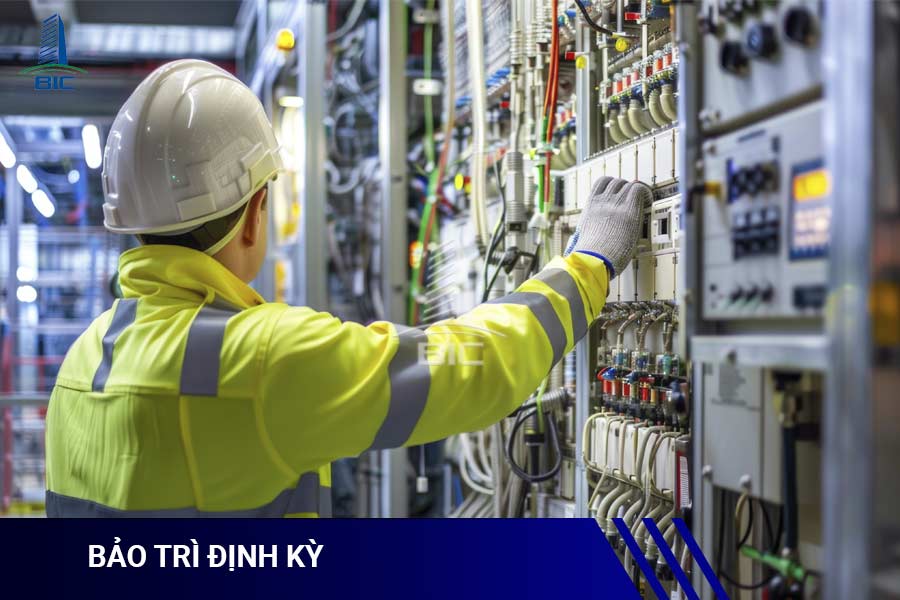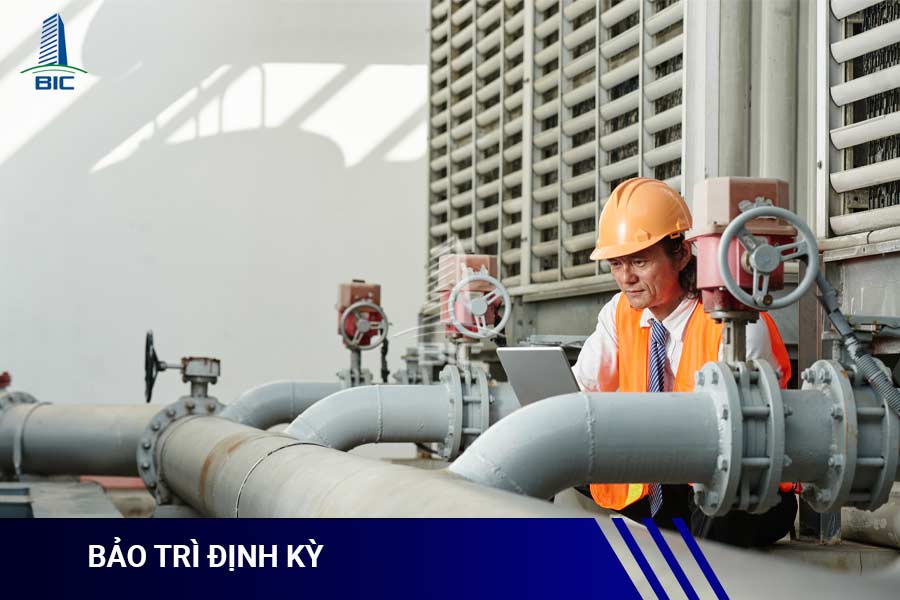
A factory is the core physical foundation of every industrial production operation. It is not only a space that houses technological systems and equipment but also a major capital asset, accounting for a large portion of a company’s fixed investment. Ensuring the factory operates safely, efficiently, and continuously is essential to maintaining productivity and maximizing return on investment.
Periodic maintenance serves as a vital infrastructure management tool that preserves the operational value of the facility while preventing technical risks that may interrupt production. A well-designed maintenance plan allows investors to control repair costs, optimize operating time, and extend the lifespan of both the structural and technical systems within the factory.
In practice, every dollar spent on proper maintenance can save several times that amount in future repairs. Therefore, integrating a maintenance plan into the overall operational strategy right after the design and construction stages is a strategic step no investor should overlook.
In this article, BIC presents a detailed, systematic overview of how to develop an effective factory maintenance plan from assessment and scheduling to resource allocation and performance monitoring. This is a valuable reference for investors who are managing or preparing to commission an industrial factory, especially amid tightening safety, productivity, and technical standards.
Periodic maintenance is a technical process involving the inspection, cleaning, adjustment, and scheduled replacement of parts that are prone to wear and tear. These activities are carried out at regular intervals to maintain the stability of the factory’s entire structure and operational systems. This proactive approach enables early detection of deterioration, prevention of technical failures, and reduction of unplanned repair costs.
In modern industrial environments especially in large-scale manufacturing facilities maintenance is no longer optional but mandatory. Systems such as electrical supply, plumbing, HVAC, and fire protection must all be regularly monitored. Meanwhile, structural components like foundations, steel frames, walls, and roofing must also be inspected periodically to ensure the building’s stability and durability.
Establishing a maintenance plan immediately after construction is a strategic move that helps investors control operational risks and maintain consistent production efficiency. This is particularly important for factories operating continuously or under strict technical requirements, such as those in the food, pharmaceutical, precision engineering, or electronics industries.

This is the foundation for defining the scope and depth of the maintenance plan. The technical management team should conduct a comprehensive survey of both the building structure and all technical systems. The assessment should include:
- Structural components: steel frames, foundations, floors, ceilings, roofing, and waterproofing layers.
- Mechanical and electrical systems: power supply, lighting, HVAC, ventilation, water supply and drainage, and fire protection systems.
- Production equipment parameters: vibration, temperature, noise, leaks, or mechanical wear.
The survey results should be compiled into a technical report identifying potential risks and prioritizing maintenance needs. This serves as the basis for developing a detailed, rational action plan.
Once the survey is complete, maintenance tasks should be classified by function, usage frequency, and their impact on production. Each group is then assigned an appropriate maintenance cycle. For example:
- Continuous operation equipment: maintain based on operating hours, typically every 500, 1,000, or 2,000 hours.
- Electrical systems: inspect every 6–12 months depending on capacity and usage.
- Steel structures: inspect for deformation, corrosion, and joint integrity at least once or twice a year.
- Roofing and drainage systems: clean after the rainy season or quarterly.
Maintenance cycles should follow manufacturer guidelines, operational data, and factory design documentation to detect damage early without disrupting production or wasting resources.
The maintenance plan should be a well-structured document organized by month, quarter, and year, including:
- A list of specific tasks for each system or structure.
- A clear schedule indicating dates, duration, and work areas.
- Assigned personnel and contractors (in-house or outsourced).
- Required spare parts, tools, and inspection devices.
- Safety measures for each activity.
The schedule must be synchronized with the production calendar to minimize conflicts. Large factories often use Computerized Maintenance Management Systems (CMMS) to automate reminders, assign work, and track progress.
An effective maintenance plan must include a detailed budget and workforce allocation. Common cost categories include:
- Spare parts, consumables, and maintenance chemicals.
- Internal labor costs or external service fees.
- Production downtime costs during maintenance.
- Testing tools and auxiliary equipment.
In terms of personnel, investors should evaluate the capability of their technical teams. For specialized systems such as refrigeration, compressed air, or fire protection, it is best to hire certified contractors with proven experience. Regular training should also be scheduled to ensure maintenance teams follow procedures, safety standards, and proper troubleshooting methods.
Once approved, maintenance tasks should be executed according to schedule and technical procedure. Each activity must follow a defined checklist, and after completion, the following information should be recorded:
- Actual condition after maintenance.
- Components repaired, replaced, or adjusted.
- Time spent and personnel involved.
- Any incidents during implementation.
Supervision must ensure compliance with safety, environmental, and technical standards. If discrepancies arise, the maintenance schedule should be revised or corrective actions added for the next cycle.
After each major maintenance cycle, investors should evaluate performance and update the entire plan based on operational data, technical recommendations, and the current condition of the factory. This ensures flexibility, cost optimization, and continuous improvement.

In a modern industrial factory, various systems and components require specialized maintenance procedures. Building a comprehensive maintenance checklist helps investors control technical risks, optimize schedules, and allocate budgets effectively. Below are the common maintenance groups to include in a periodic plan:
- Steel frames and columns: Check joints, bolts, corrosion, and protective coatings; inspect connections to the foundation and roof for deformation every 6–12 months.
- Industrial concrete floors: Inspect for cracks, settlement, surface wear, or peeling; clean regularly to prevent buildup of dust, oil, or chemicals.
- Walls and ceilings: Clean surfaces, inspect waterproofing and paint, check insulation systems.
- Roofing: Inspect for leaks, damaged panels, supporting structures, and drainage capacity especially after the rainy season.
- Electrical cabinets and wiring: Clean panels, tighten terminals, test insulation resistance, and use infrared cameras to check hot spots.
- Lighting: Replace defective bulbs, verify lighting intensity in production areas and emergency exits.
- Grounding and lightning protection: Test grounding resistance and inspect lightning conductors as required by technical regulations.
- Water supply: Check for leaks, corrosion, pressure, and material integrity at joints and bends.
- Drainage systems: Clean floor drains, traps, and exhaust pipes to prevent clogging or odor.
- Water tanks: Clean inside and outside surfaces, check covers and inlet/outlet pipes for hygiene and safety.
- Industrial air conditioners: Clean coils, filters, and fans; inspect refrigerant levels and follow manufacturer maintenance schedules.
- Ventilation and dust extraction fans: Check vibration, rotation speed, and filter cleanliness to ensure air circulation and temperature control.
- Air pressure and filtration systems: Replace filters periodically and monitor pressure differentials for consistent performance.
- Sprinkler systems: Inspect water pressure, nozzle sensitivity, corrosion, and leaks.
- Fire cabinets and extinguishers: Check pressure, expiry dates, and positioning per approved fire safety plans.
- Fire alarm systems: Test smoke and heat sensors, sirens, and signal cables to ensure accurate operation during emergencies.
- Motors, conveyors, CNC machines, packaging lines: Check lubrication, alignment, vibration, temperature, and noise; replace worn parts such as bearings, belts, or filters as needed.
- Compressed air systems: Inspect pressure, moisture separators, valves, and joints for leaks; service compressors and filters per manufacturer recommendations.
- Control cabinets: Update software, verify I/O signals, inspect cooling fans and electrical connections.

Regular maintenance is not just a technical necessity, it’s a strategic investment that enhances operational efficiency and asset value over the long term. Below are the key benefits for investors:
Scheduled inspections, adjustments, and cleaning maintain all components in optimal working condition, helping factories achieve designed capacity and minimize downtime losses.
Maintenance prevents corrosion, wear, and structural deterioration, enabling early correction of minor issues before they become costly repairs. This significantly extends the life of building structures, MEP systems, and production equipment.
Unplanned breakdowns often cost many times more than preventive maintenance due to urgent repairs, production losses, and potential reputational damage. Planned maintenance helps control and forecast these expenses effectively.
Periodic inspection of fire safety, emergency lighting, ventilation, and escape systems ensures workplace safety and compliance with legal standards reducing the risk of accidents and legal penalties.
Efficient maintenance lowers energy consumption, increases production reliability, and delays replacement cycles reducing operating costs and enhancing factory value. Well-maintained facilities with proper documentation also achieve higher market and resale value.

Despite its importance, many factories make mistakes that reduce maintenance efficiency or inflate costs. Common pitfalls include:
- Delaying maintenance planning: Waiting until after the factory is operational leads to poor accessibility and higher future costs.
- Overlooking key items: Ignoring seldom-used but critical systems such as roofing, sub-electrical panels, or drainage lines can cause major disruptions later.
- Not updating plans: Failing to adjust the maintenance plan based on new equipment, production changes, or facility expansion results in inefficiency.
- Improper resource allocation: Inaccurate budgeting or manpower planning leads to incomplete or substandard maintenance work.
- Lack of monitoring systems: Manual tracking without data records makes it difficult to evaluate performance or demonstrate compliance.
Periodic maintenance planning is not just a technical task, it is a vital component of industrial asset management. A properly maintained factory ensures maximum productivity, minimizes operational risks, and strengthens long-term sustainability.
From the moment a factory’s design phase is complete, investors should establish a comprehensive maintenance strategy covering both the building structure and all supporting systems. This approach optimizes operating costs, ensures consistent performance, and lays the foundation for stable business growth.
Investing time and budget into maintenance should be viewed not as an expense but as a strategic investment, one that protects assets, ensures production safety, and maintains competitive advantage. By embedding periodic maintenance into the overall factory management strategy, businesses can operate confidently, minimize risks, and sustain high performance across all dimensions.